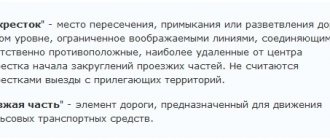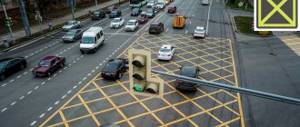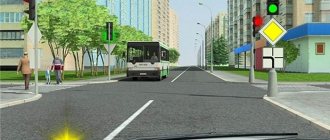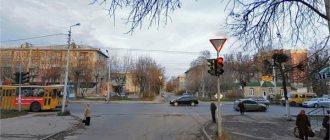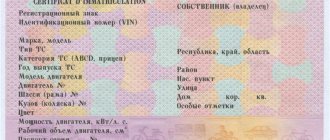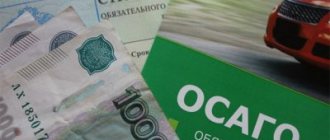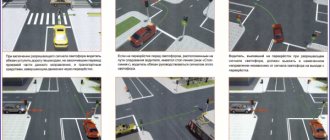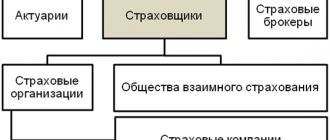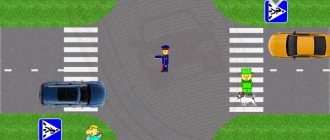First, let's define what is meant by the word “road intersection”.
This is the point or place where roads cross at the same level. The boundaries of the intersection are virtual lines that visually unite the beginnings of the curves of the roadways. The key word in our formulation is “intersection”. At this point, one car must let another car pass, in accordance with section 13 of the Road Traffic Rules (hereinafter referred to as traffic rules).
In order to easily understand the traffic situation and correctly determine who will cross the road intersection first and who should wait a little, you need to accurately navigate which intersection you find yourself at.
Description
In accordance with paragraph 13.3 of the traffic rules, there are 2 types of intersections.
Adjustable
They have a traffic light installed and operating in normal mode, and it is responsible for the correct passage of cars. Depending on his signals or the inspector’s instructions, traffic participants stop or resume their movement.
Important!
If suddenly the traffic light is faulty, turned off, or “yellow” is constantly flashing, we have an unregulated intersection in front of us. Here, drivers and pedestrians are required to adhere to the existing rules governing passage at intersections of this type and take as a basis the road signs of intersections, which will be discussed a little later.
Unregulated
They are determined by the absence of any regulation, and specifically: the traffic light is not working or has switched to “yellow flashing” mode, there is no traffic controller. In this case, everyone needs to be careful and it is advisable to quickly remember the rules for driving through such intersections.
Road intersections can take various forms:
- Quadrilateral in X shape;
- three-sided in the shape of the letter T;
- three-sided Y-shaped with different adjacent ones and at any angle;
- with circular motion.
Types of intersections
According to paragraph 13.3, all intersections are divided into two large groups:
- Adjustable - on such vehicles, the order of movement of the vehicle is determined by the signals of the traffic light or traffic controller.
- Unregulated - there is no traffic light on them or is not currently working. To drive through them safely, drivers must follow the priority signs and the “right hand” principle. This type of intersection includes two subgroups:
- intersection of equivalent roads;
- intersection of uneven roads.
Occasionally, roundabout intersections are included in a separate third group. However, they can also be classified as one of the subtypes of unregulated intersections.
Explanation
Signs that determine the order of travel at uncontrolled intersections and various intersections (intersection road signs in traffic rules) are classified as priority signs. Basically, they are made in the shape of a triangle with a red rim and at first glance resemble warning signs. Signs indicating priority are placed in advance of intersections; their task is to ensure traffic safety in these areas.
They can be roughly divided into groups.
the main road
Sign 2.1 is “main road”. The driver, seeing this sign, immediately understands that he is a “priority” and can cross the uncontrolled intersection first and not let anyone through. But in any case, he must be extremely careful and slow down, there is a possibility that the other driver may get lost and then a collision cannot be avoided.
Sign 2.1 - “Main Road”
Sign 2.2 “end of the main road” - everything is extremely simple with it. Be careful, the advantage is gone.
This sign does not turn the main road into a secondary one, it is simply now an intersection of equivalent roads.
Sign 2.2 - “End of the main road”
minor road
2.3.1 “Intersection with a secondary road” and 2.3.2 - 2.3.7 “Junction with a secondary road” are similar in meaning and carry information that two roads intersect in front of you: the main one with the secondary one.
It can adjoin the road surface at any angle. These road signs are usually installed outside the city, outside populated areas; they indicate to the motorist that there is an advantage over those on a secondary road.
Sign 2.3.1 - “Intersection with a secondary road”
2.4 “Give way” and 2.5 “Driving without stopping is prohibited” inform the driver that he is on an adjacent secondary road and must wait and let everyone on the main road pass.
When leaving a residential yard or an adjacent area, even if sign 2.4 is missing, give way!
Sign 2.4 - “Give way” and sign 2.5 “Driving without stopping is prohibited”
Equivalent intersection
This is the intersection of roads of equal importance.
Travel rules for each type
General requirements for driving through intersections, without taking into account their varieties:
- Pedestrians and cyclists who move across the vehicle’s path always have the right of way. In this case, it does not matter whether the intersection is regulated or not;
- All types of intersections are subject to a ban on leaving if there is a traffic jam. As a result, not only will the traffic jam increase, but traffic will also be blocked for cars on the right or left.
Rules for driving at an equivalent uncontrolled intersection
The main requirement for drivers is to follow the “right hand” rule. That is, those vehicles that approach the intersection on the right have the advantage in this section.
For example, when the driver’s trajectory (A) runs straight along an equivalent cross-shaped intersection, and to the left (B) and right (C) of him there are two more cars, also moving in a straight line. Then driver A is obliged to give way to driver C, since he is located on his right hand. And after that, driver B must let driver A pass and only then drive in a straight line.
If, when driving in a straight line at such an intersection, the oncoming car plans to turn to its left, then the latter is obliged to let the vehicle moving straight ahead, and only after that complete the maneuver.
Roundabout Circulation
Starting from 2021, motorists already on the ring have priority on the ring. All vehicles entering the circle are required to give way. The exit is carried out according to the “right-hand” principle, giving priority to all drivers on the right side.
Equivalent to tram tracks
According to clause 13.11, a tram always has the right of priority over trackless transport (with the exception of leaving the depot). The “interference from the right” rule does not apply in this case.
Uneven uncontrolled intersection
In this case, cars moving on the main road have priority. Their further trajectory does not matter.
If the main road changes direction at an intersection, then motorists entering along it have equal rights relative to each other. They need to be guided by the principle of “interference from the right.” All vehicles on secondary roads are required to give them priority.
You can determine the main road by the presence of one of the following signs:
- Installed road signs 2.1, 2.3.1-2.3.7 or 5.1.
- Type of road surface: Asphalt has an advantage over primer.
Rules for driving at controlled intersections
The order of passage is regulated by signals from a traffic light or, less commonly, from a traffic controller.
The following principles apply:
- all vehicles that start moving at the main traffic light signal apply the “right hand” rule relative to each other;
- when simultaneously entering the intersection on the main green signal of a tram and other trackless transport, the tram has the advantage;
- When starting to move on the green light of an additional section of the traffic light, you must first let through everyone whose main green light is on and then make a maneuver.
Comments
We often notice that the “Main Road” sign is combined with an information plate (clause 8.13), on which the direction of the main road is drawn. This is done so that it is clear how the main road will change its bend at the intersection. If there is no such sign, then it goes straight through the intersection.
If traffic light signals contradict the requirements of priority signs, then in accordance with paragraph 6.15 of the Traffic Regulations, drivers are guided by the traffic light signals.
Sign 2.1 - “Main Road” with sign 8.13 “Direction of the Main Road”
Uncontrolled intersection and controlled pedestrian crossing
How to drive through a pedestrian crossing was previously discussed in the articles Passing pedestrian crossings at intersections and Pedestrian crossings outside intersections. The material is presented in sufficient detail. But, nevertheless, intersections can have very different configurations, and the presence or absence of road attributes on them can sometimes mislead even an experienced driver.
Very rarely, but still there are T-shaped intersections, where the organization of travel is arranged in such a way that the first time you will not understand how to get through it without violating the Rules. We will talk about uncontrolled T-shaped intersections, on one of the roads of which there are controlled pedestrian crossings.
The driver is presented with an ambiguous picture. Approaching the intersection from the side of the traffic light, he sees a controlled intersection. And there are no questions about how to get through it. And when approaching the same intersection from a side road, the driver sees road sign 2.4 “Give way” instead of a traffic light.
Having given way to those driving on the main road and, according to all the rules, having entered an intersection, at the exit from this intersection the driver “runs into” a traffic light, where, as always, at the wrong time, the red light comes on. What to do at this moment: stop or move on? Will it be considered a violation to leave an intersection when the traffic light is red in this case?
In many controversial cases, the most accurate answer has always been considered the answer from the traffic police representative in this particular case. But the thing is that the cases may be similar, but they occur in different traffic situations. Moreover, they occur at outwardly similar intersections, but with different organization of passage to them. So it turns out that in one case the action is permitted, and in another case it is prohibited.
Below we will look at several situations and try to figure out how to properly drive through controlled pedestrian crossings at an unregulated intersection.
Let's take the case mentioned earlier in the comments to the article Driving through signalized intersections. In front of you is a T-shaped intersection, on one of the roads there are controlled pedestrian crossings. A traffic light regulates the flow of cars, and a pedestrian traffic light is installed for pedestrians.
Let us first consider driving through such an intersection along the main road, i.e. under a traffic light (conventionally, the crossbar of the letter T). What does the driver see when he approaches this intersection on the main road?
First of all, he sees a traffic light, which, suppose, has a red light on, and sign 5.19.1 “Pedestrian crossing”. What will his actions be? Answer: the driver, according to paragraph 6.13 of the traffic rules, must stop in front of the stop line, if there is one, or at the traffic light line. At this moment the green signal is on for pedestrians and they can cross the road. In this situation, the road situation is clear to the driver.
Let's move on. Let's assume that the driver on this road entered the intersection on his green signal or on his flashing green signal, and when he approached the second traffic light, the second one had already turned red. What should he do in this case - complete the crossing, or stop at the traffic light?
The answer to this question is given by paragraph 13.7 of the traffic rules. If there is a stop line in front of the traffic light (sign 6.16 “Stop”), then stopping is mandatory! If there is no Stop Line, then you can complete the crossing by giving way to pedestrians.
But keep in mind that at this moment the green signal is on for pedestrians, and they have every right to move through the crossing. If you try to “squeeze” through pedestrians, and some pedestrian, for example, wants to play on this and suddenly throws himself under your wheels, then you will be guilty.
Therefore, if you are not sure that the passage in this case will not contradict the traffic rules, stop at the red signal before crossing and wait for your green signal.
This is exactly what you need to do if you have to drive through such an intersection from a side road, i.e. from under sign 2.4 “Give way”. There is no traffic light in front of the intersection, and when traffic on a straight road is intense, it is possible to enter the intersection to turn right or left only when the side traffic lights turn red - on the main road the flow of cars stops and it becomes possible to enter the intersection with the secondary one. Pedestrians, if any, begin to cross the road at their permissive signal.
Having entered an intersection (either to turn right or left, it doesn’t matter), the driver again “runs into” his own red traffic light at the exit from the intersection. There was no traffic light at the entrance, i.e. in fact, the intersection is unregulated, and exit from it, it turns out, is already regulated by a traffic light. What to do in this case: drive on or stop and wait for the green signal?
Let's look at this situation from two sides: according to traffic regulations and from the point of view of traffic safety.
According to clause 13.7 of the traffic rules, the driver “... must drive in the intended direction regardless of the traffic light signals at the exit from the intersection...”. But unlike the first case (driving on a straight road under a traffic light), here you are entering an unregulated intersection, and paragraph 13.7 says nothing about this. In general, only lawyers can understand such subtleties, but not every driver is a lawyer. Therefore, let's look at the situation through the eyes of an ordinary driver.
The ideal clue in this case would be the presence of a Stop Line (Stop Sign 6.16) at traffic lights. If there is a Stop line in front of the traffic light, then stopping is strictly required! and no one would have any questions in terms of “should I or shouldn’t I stop?” But it often turns out that there are no “Stop” signs at traffic lights, and here lies the “catch”.
You can talk and argue for a long time about what the right thing to do in this case is to drive further, letting pedestrians pass, or stop and wait for the green signal, but our task is not to catch the driver in violation, but to drive through the intersection in such a way as to avoid an accident and disagreements with the inspector.
A traffic light regulates a pedestrian crossing, and a pedestrian can appear at the crossing at any moment, and, seeing his own traffic light signal, he can rush across the road, hoping to quickly cross the roadway. If the path of the turning car and the pedestrian intersect at this moment, then the driver will be guilty, with all the ensuing consequences.
Besides, a traffic light is a traffic light, it’s not for nothing that it’s installed there. After turning from under the 2.4 “Give Way” sign, you must, in any case, regardless of the presence of a Stop Line, stop at the traffic light and wait until the green light turns on. Wait, regardless of whether there are pedestrians or not. The green light came on - let's move on.
Let's take another intersection, not as large as the one discussed above, but the situation is almost the same: the exit from the secondary road from under the sign 2.4 “Give way” comes up against a traffic light, which regulates both the traffic flow and the movement of pedestrians. This intersection is taken from the road network of the city of Komsomolsk-on-Amur.
You need to pass it in the same way as discussed above: turn right from a minor road - stop before turning red - wait for the green signal - continue driving. And no one will have any questions: neither you to the pedestrians, nor the inspector to you.
Now imagine that the traffic lights at the intersections in question are turned off, i.e. they do not work at all or work in yellow flashing mode. In this case, pedestrian crossings acquire the status of uncontrolled crossings, like the intersection itself, and the driver is obliged to follow the rules for driving through uncontrolled intersections and unregulated pedestrian crossings.
When traffic lights are turned off, regardless of the direction of movement, the driver is obliged to give way to a pedestrian crossing the road. Giving way to a pedestrian means not interfering with him, even if you have to stop to do so. I recommend the article Pedestrian crossing and the requirement to give way to pedestrians.
The rules are not perfect. There are cases when a driver manages to defend his case and challenge the fine imposed for driving through a pedestrian crossing on a red signal in his favor. But not everyone has the patience and time to understand such issues. After all, the main thing on the road is, after all, not the art of avoiding fines, but safe driving. Those. driving a car in such a way as to avoid an accident. And the cost of an accident can be someone’s health or someone’s life.
So, when driving through such pedestrian crossings, be very careful.
Fines
Failure to comply with the rules for driving through intersections entails the imposition of administrative penalties. A detailed table of fines can be found here.
Based on clause 12.12 part 1, for driving through a red traffic light or a traffic controller's prohibitory sign, the driver is charged a fine of 1,000 rubles.
In the event that the driver of the vehicle does not allow a car to pass, which has the right of way through the intersection, in accordance with clause 12.13, part 2, the fine is 1000 rubles.
Systematic failure to comply with the requirements of traffic rules and repeated violations can lead to more serious consequences: a fine of 5,000 rubles or deprivation of a driver’s license for a period of 4 to 6 months (clause 12.12, part 3).
Concepts of intersection and surrounding area
Let's start by looking at the basic concepts that will be used in the article:
“Intersection” is a place where roads intersect, adjoin or branch at the same level, limited by imaginary lines connecting, respectively, the opposite, most distant from the center of the intersection, beginnings of curvatures of roadways. Exits from adjacent areas are not considered intersections.
“Adjacent territory” is the territory directly adjacent to the road and not intended for through traffic of vehicles (yards, residential areas, parking lots, gas stations, enterprises, etc.). Movement in the adjacent territory is carried out in accordance with these Rules.
So, according to these concepts, the main difference between an intersection and the surrounding area is the infrastructure facilities to which the intersecting roadway leads.
An example of an intersection (its panorama):
An example of the adjacent territory - leaving the yard (its panorama):
So, the two previous pictures did not cause you any difficulties, but in practice this is not always the case.
Unsolvable situation at the crossroads
A traffic situation may arise at an intersection from which it is impossible to find a way out within the framework of current traffic rules.
It consists in the fact that cars approach an equivalent intersection simultaneously from all directions. Moreover, at each of the four entrances there is at least one car whose driver wants to drive straight, turn left or turn around.
The essence of this insoluble situation is that each driver must give way to the other car (which is on his right). White is inferior to orange, orange is inferior to blue, blue is inferior to green, green is inferior to white. Therefore, they are all forced to stand and cannot pass.
A way out of this situation can be found as follows. All vehicles approaching from one direction must turn right. In this case, the remaining cars will gradually be able to move apart.
